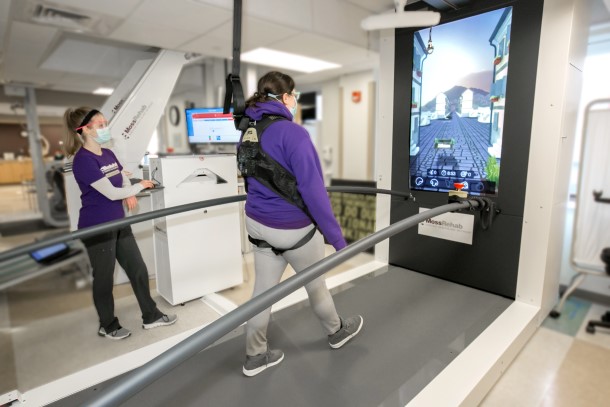
Part two of our series on therapeutic gaming focuses on how physical and occupational therapists use this technology in the clinic.
MossRehab is tapping into the benefits of therapeutic gaming by introducing and maintaining an extensive portfolio of rehabilitation equipment featuring gamification at its Elkins Park and several satellite locations. Our therapists use the different technologies to supplement conventional practices during inpatient and outpatient rehabilitation.
“I use therapeutic gaming as a tool to facilitate motor recovery through repetition of desired movement patterns,” says Casey McKee, OTR/L, who treats outpatients and the occasional inpatient at MossRehab Elkins Park. Most of her patients have impairments caused by stroke, traumatic brain injuries, multiple sclerosis, and Parkinson’s Disease that require occupational therapy to overcome limited functional ability to complete everyday tasks. “Games motivate patient participation while providing the opportunity for real-time biofeedback. The support level is customizable, allowing therapists to upgrade or downgrade tasks based on patient performance.”
As rehabilitation therapy is highly individualized at MossRehab, a diverse robotic technology collection enables therapists to treat various impairments matching the patient’s different capacity levels. “There's not one kind of typical gaming therapy to improve all movements of the arms or legs,” explains Andy Packel, PT, NCS, locomotor coordinator at MossRehab. “Therapists choose devices that best support treatment plans for their patients.”
Working on the upper body
For example, our Armeo® Therapy robots support physical therapists by providing features with exercises that improve strength and range of motion. Other robots that focus on the upper body include the Amadeo® for hand-finger rehabilitation and the Diego® VR for training lost arm-shoulder functionalities. All have interactive games to increase patient engagement.
“I used the Amadeo with a pediatric patient diagnosed with acute flaccid myelitis that caused difficulties with finger extension. Through games available on the Amadeo, the patient seemed to view therapy as less of a chore and more of a game,” McKee explains. “As progress with this diagnosis is not always linear, features on this device allowed me to adjust the challenge level. This patient benefitted from the engagement prompted by the high-repetition movement patterns experienced in the various therapeutic games. I am not certain he would have tolerated such intensity if not motivated through gaming.”
The Myro® is another therapeutic robot with gamification features available at MossRehab for upper extremity rehabilitation. The Myro offers a sensor-based surface much like an extra-large touch screen computer, with force control and tactile applications.
“I use the Myro extensively in occupational therapy to improve range of motion for the entire arm and address cognitive skills,” remarks Stephanie Farm, MS, OTR/L, occupational therapy team leader at the MossRehab Drucker Brain Injury Center. “The Myro has various fine motor attachments, so patients can use a joystick to work on gross grasp skills, a pencil for pre-handing writing activities, or a coin piece to promote finger pinch. Cognitive games also prompt patients to scan the screen and identify items that don’t belong or find missing components to complete a sequence.”
The Myro also provides real-time feedback on performance that motivates patients to do better. “Patients love hearing that they used their arms for five minutes on level four today, progressing from level two for one minute two weeks prior,” says Farm. “The computer games are more customizable and motivating than conventional therapy tasks.”
Gait rehabilitation
MossRehab has two Lokomats®, a G-EO, and a Lyra device at one site, making it possible for patients who experienced a stroke, traumatic brain injury or spinal cord injury to benefit from robot-assisted treadmill therapy. Supporting patients in a harness above a treadmill, the Lokomat or with feet strapped to short platforms these devices assists the body to improve walking. Various therapeutic game-like exercises in each of the devices help patients meet their goals.
“If a patient is having trouble lifting their hip, a therapist can set up a game where that robot provides assistance or resistance to the hip to accomplish a task,” says Packel. “The therapist can identify activities that offer the right amount of challenge that help patients reach their goals.”
MossRehab recently added the C-Mill®, a high-tech treadmill that features a large LCD screen and an overhead projector for gait rehabilitation. The C-MIll offers augmented and virtual reality games that replicate real-life activities to prepare patients for the world. “The C-Mill has various games ranging from simple to complex,” notes Matthew Vnenchak, PT, MS, NCS. “One application requires a patient standing at an intersection of two crossing roads to lift their leg if a car approaches from the right or left to avoid it. The C-Mill gives visual and auditory real time feedback if a patient successfully or unsuccessfully completes the task for reinforcement.”
MossRehab is continuously adding to its portfolio of therapeutic gaming equipment. Scientists and clinicians continually evaluate new technologies and work with manufacturers to upgrade and develop new applications. “We test equipment in the clinic and provide feedback on what equipment developers might add or change that would benefit the patient,” says Packel.
The range of our gaming therapy choices also pleases our clinical therapists and patients. “One of the benefits of working at MossRehab is access to so many advanced rehabilitation tools,” explains Farm. “We are fortunate to work with some of the most innovative technology to support the rehabilitation plans of both inpatient and outpatient treatments.”
In our final installment of the series, we will look to the future of therapeutic gaming and explore how scientists at the Moss Rehabilitation Research Institute (MRRI) are pushing the boundaries of gaming therapy in their latest research projects.
Read Therapeutic Gaming Part 1: Engaging Patients and Therapeutic Gaming Part 3: Leading the Future now.